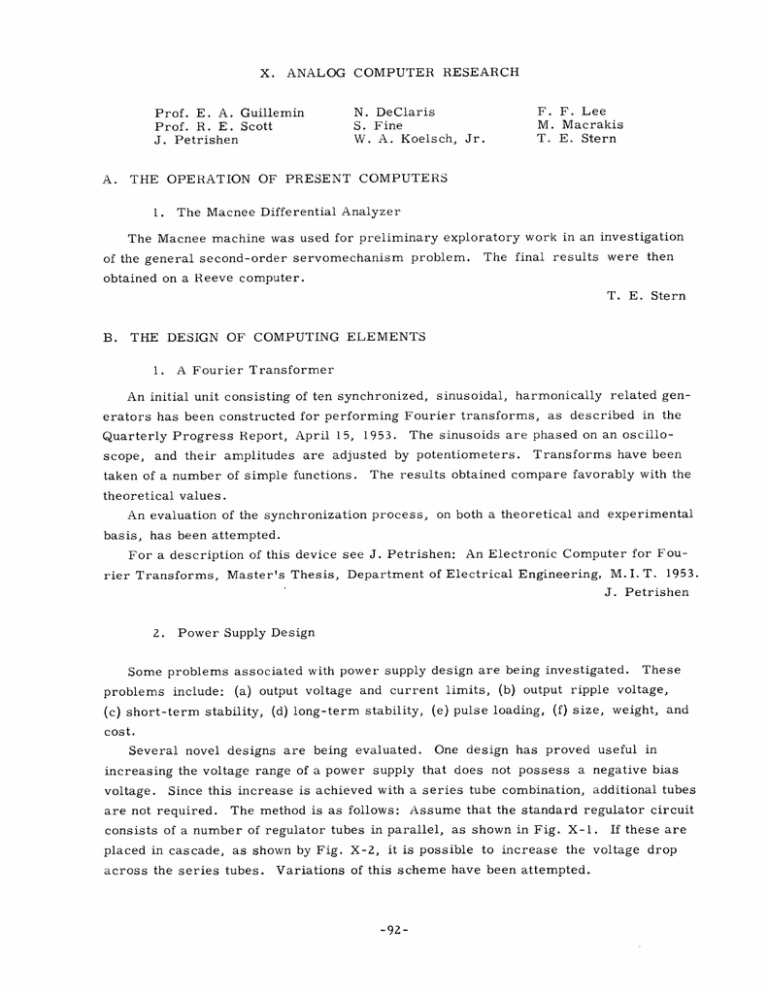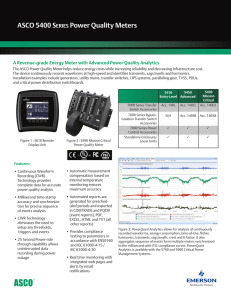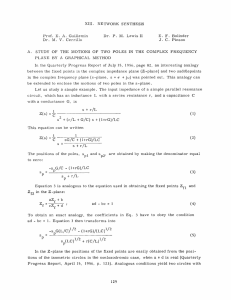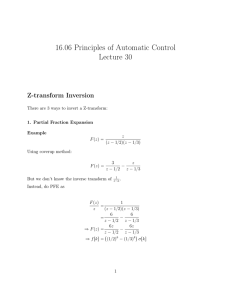X. ANALOG COMPUTER RESEARCH F. Lee
advertisement

ANALOG COMPUTER RESEARCH
X.
Prof. E. A. Guillemin
Prof. R. E. Scott
J. Petrishen
A.
N. DeClaris
S. Fine
W. A. Koelsch, Jr.
F. F. Lee
M. Macrakis
T. E. Stern
THE OPERATION OF PRESENT COMPUTERS
1.
The Macnee Differential Analyzer
The Macnee machine was used for preliminary exploratory work in an investigation
of the general second-order servomechanism problem.
The final results were then
obtained on a Reeve computer.
T. E.
B.
Stern
THE DESIGN OF COMPUTING ELEMENTS
1.
A Fourier Transformer
An initial unit consisting of ten synchronized,
sinusoidal, harmonically related gen-
erators has been constructed for performing Fourier transforms, as described in the
Quarterly Progress Report, April 15,
scope,
1953.
The sinusoids are phased on an oscillo-
and their amplitudes are adjusted by potentiometers.
taken of a number of simple functions.
Transforms have been
The results obtained compare favorably with the
theoretical values.
An evaluation of the synchronization process, on both a theoretical and experimental
basis, has been attempted.
For a description of this device see J. Petrishen:
An Electronic Computer for Fou-
rier Transforms, Master's Thesis, Department of Electrical Engineering,
M. I. T.
J.
2.
1953.
Petrishen
Power Supply Design
Some problems associated with power supply design are being investigated.
problems include:
(a)
These
output voltage and current limits, (b) output ripple voltage,
(c) short-term stability, (d) long-term stability, (e) pulse loading,
(f) size, weight, and
cost.
Several novel designs are being evaluated.
One design has proved useful in
increasing the voltage range of a power supply that does not possess a negative bias
voltage.
Since this increase is achieved with a series tube combination,
are not required.
additional tubes
The method is as follows: Assume that the standard regulator circuit
consists of a number of regulator tubes in parallel, as shown in Fig. X-l.
placed in cascade,
If these are
as shown by Fig. X-2, it is possible to increase the voltage drop
across the series tubes.
Variations of this scheme have been attempted.
-92-
(X.
ANALOG COMPUTER RESEARCH)
Fig. X-l
Fig. X-2
Regulator tubes in parallel.
Regulator tubes in series.
Therefore,
with a standard power supply, a lower regulated voltage can be obtained
from the same unit for a specified input voltage.
Conversely, the same regulated voltage
can be obtained for a higher input voltage than the range obtainable with the original
Successive cascading can be accomplished in the same manner.
supply.
S. Fine
3.
Two-Dimensional Visual Display
Present visual displays are not ideal for several reasons.
The mechanical displays
are too slow, and a cathode ray tube is too inaccurate. Furthermore, in common with
all angularly deflected display devices the cathode ray tube has an adverse ratio of
volume to indicator surface.
Preliminary work has been done on a new display device of a different type. The new
device depends on two electronic units. The first unit is a voltage-to-linear-scale conThe operation performed is the conversion of a voltage amplitude into a linear
displacement along a nonlinear artificial transmission line. The location of the signal
verter.
is characterized by the peak of a triangular voltage distribution along the line. Procedures have been developed for determining the parameter values to be used in the line
and in the driving source.
Because the output voltage can be read only at the nodes of
the line, a process of digitalization is implicit in the method.
The second component of the proposed system is a multiple-element gaseous discharge tube, which will be used with one or more of the voltage-to-linear-scale converters to give a visual indication of the position of the voltage peak and hence of the
amplitude of the given input voltage.
Two models of the gas tube have been constructed and the results obtained are
promising. Further research, however, must be done to produce a really practical
device.
The voltage-to-linear-scale
converter already works very well and can be
applied to analog-to-digital conversion, coding, multiple-decision switching, and electronic control of multiple-unit systems.
W. A. Koelsch, Jr.
-93-
(X.
C.
ANALOG COMPUTER RESEARCH)
APPLIED NETWORK THEORY
Approximations on Network Synthesis
1.
A procedure of obtaining transfer functions for RC-filter networks through a method
A more general method
of interpolation to known functions was presented previously (1).
for determining transfer impedance functions with arbitrary poles anywhere in the left
half of the s-plane to give any predescribed modulus-frequency
investigation.
response is under
The method is to be based on an interpolation procedure.
The main reasons for undertaking this study are the following:
First, there exist
methods of approximation which, with rational functions in the complex plane,
achieve
very satisfactory results as far as the mathematical problem of approximation is concerned.
However,
they lack the freedom of preassigning the location of the poles.
This
disadvantage is very important for the engineering problem, inasmuch as it is the location of the poles that determines the character of the network to be synthesized.
For
instance, none of the existing standard methods of approximation result in a transfer
Second, most of the standard approximation methods,
impedance of RC character.
order to obtain a high "Q"
poles
circuit, result in a transfer function with at least a pair of
close to the j-axis.
required.
in
To realize this network,
coils of very high Q are often
However, it is well known that it is possible to design high-Q circuits with
low-Q elements.
It is true that the latter may require more elements, but the question
as to which one is the most economical is one of engineering judgement.
a.
Mathematical development
The following is a short presentation of a sequence of orthogonal functions useful in
approximating transfer functions by means of rational functions,
linear networks,
realizable as passive
in the complex s-plane.
Let the function f(z) be analytic on and within c: Izi
=
1, and let the function r(z) be
of the form
c z
n-i
o
rn
+ clz
1
n-2
+...
c
n-1
,
z = x + jy
(z - ak)
interpolating f(z) at the points 0, P 1 .
1)
f( 2 )
z -
. .. .
Pn-1.
To construct r(z), let
l
z _ l +-_(z - l) (z -a 2
z= 2
z
fQ3 .zji .
-94-
(1)
(X.
ANALOG COMPUTER RESEARCH)
which suggest that
alz
r(z) =a
a2 [1 - (1/PlZ)]
(z - a) (z - a2)
+
a31
-
[1 - (I/,2z)]
2) (z - a3)
(/Pz)
(z -
(z - a)
The general form of expan-
k.'
indeed interpolates the function f(z) at the given points
(3)
sion of f(z) is
fl(z) = K 1 C 1 (z) + K 2 C 2 (z) + ...
If fl(z) is to be expanded in accordance with
where Ck(z) is a sequence in the variable z.
the least-mean-square-error method, Ck(z) must be a set of orthogonal functions.
Hence
it is required that
IdzI = 0,
Ck(z) Cn(z)
n
k
(4)
If we identify fl(z) with r(z),
C (z)= 1
C(z)
z
z -z a
P
z
C 2 (z) =
1
UP 1)Z]]
(z - al) (z - a 2 )
and it is sufficient for the orthogonality condition if Pi
=
1/
1
C (z) = 1
C1()(z)
C
=
z-a
z
1
z(1 -a
C (z) = (z-
)(
iz)
(5)
z - CL2 )
The coefficients ak are theoretically given by
k-1
ak
ri
akak - 1
-
Zrj
c
f(z)
(z-
m
)
(1-
Imz)
k
i
z
m=1
-95-
dz,
k
0
(X. ANALOG COMPUTER RESEARCH)
However, a much more convenient way by which complex integration can be avoided is
to observe that
a 2z(1 - az)1
alz
r(z) = a +
+ (
z - al
o
a
3
- al) (z - aZ)
z(1 - alz) (1 - a 2 z)
) ( - a
) ( +(Z-l)(Z-z)(-3
Therefore
is equal to f(z) at the point 1/ak.
a
= f(o)
a
=1-Q
111 l
a2
-
a2
Z
f
/
1 -a3a3
a3
-a
(1 - al aZ)
12
-
1 -ca
.
a3 - aZ
a
3
-
Consider the N-th term
N
I-
N
z - aN+l
CN()
- a2 )
At this point it will be necessary to investigate
(z - al)(z - a2)(z - a3) ...
z
a
-f a
- a z ) ...
z(l - al ) (
i
1i
1
- a13
the convergence of the sequence of Eq. 5.
Now let 1/
- al
f 2- a]
a3 - alI
A complete table can easily be made.
CN(Z)
"'
z -aN+
Z - a.
1
i (1/a). z]
N
z
i= 1
I
1 - a.z
=
i=l
i
.
ai z(I/l)-
1
= Pi
N
Ni-
('i-
z - aN+ C(z)
z
N(Z)
i= 1
N
-2
i=l 1 pi
IP.13
11*,
(zn. - 1)
ii
SI
The above expression is
z)
i=l
( z- z)
(3zz - z)
i- z)
(zpi-
1)
identified as the Blaschke product corresponding to the
-96-
(X.
sequence
p . It is known that
pi
N
lim
t
Non c:
I
ANALOG COMPUTER RESEARCH)
=
1, provided
< 1
fPil
(Pi - z)
= 0
1
(Zpi- 1)
i=l I il
and the sequence
N
i=l
converge. Consequently, it has been proved that the function
rN(z)
N(z)
=
a
o
+ a
z
z-
l
z(1 -
z(1 -az)
+ a(
2(z-al)(z-a
l z) (1
-
2
52 z)
a3 (z - al) (z - a 2 ) (z - a )
3
lie interior to c:
converges on the circumference c, if the points 1/
b.
I zl
= 1
Application to network theory
In this section the mathematical ideas developed previously will be applied directly
to the approximation problem of network synthesis.
The problem as it stands is to find
a rational function R(s) of the complex variable s (s = a + jw) to meet certain desired
magnitude and phase characteristics along the imaginary axis, within a specified tolerance, while some freedom is permitted pertaining to the location of the poles.
the desired characteristics
are given as plots of the real frequency w.
Usually
It will be
assumed that a function F(s) has been found to satisfy the magnitude and phase requirements. The function F(s) does not necessarily need to be rational though it must be
analytic throughout the right half-plane of the s-plane.
References 4 and 5 elaborate on
this specific problem.
Consider the function
s-1
sZ-1
s+l
(8)
or
s
1+z
-z
*There is a discontinuity for z = + 1, but the function is to be approached along the
unit circle and not along the real axis.
-97-
(X.
ANALOG COMPUTER RESEARCH)
F/No
PLANE
S-
Z - PLANE
Fig. X-3
A transformation of the s-plane.
This is a well-known transformation through which the right half-plane of the s-plane
corresponds to the unit circle in the z-plane (see Fig. X-3).
Furthermore,
the nega-
tive and positive real axis of the z-plane represents the negative real axis segments,
0 to -1 and -l
to -oo,
Let the function F(s) be of the form
of the s-plane.
m
(s +
'k) (s +
F(s) =A k=l
k)
(9)
a-
i) (s +
(s +
i)
then its transform on the z-plane is
2(n-m)
=l
I/
-
s
-
-
T
n
(1-z) FI (z + ak) (z +
k=l
i=l
r
k)
+-lJ
(z +
i) (z +
(10)
i)
where
1+
+ ii
i
1-m
1
k
m
K=A
k=l
ni
i=l
It is
obvious that the function f(z) is analytic inside the unit circle.
can be approximated on c:
z I = 1 by the series
-98-
Therefore, it
(X.
(
-z a
r(z) = a 0 +
ANALOG COMPUTER RESEARCH)
z(1 - alz)
z
- a
(11)
Further study of the convergence of the
The sequence of a's is not to be arbitrary.
product
N
(12)
_
k
k=1
is required in order to establish a measure of the degree of convergence of the series
in Eq. 11. Furthermore, a's must be selected in conjugate pairs in order for r(z) to
After the necessary algebraic steps, r(z) can be set in the form
have real coefficients.
+
qo
+ ' '
q 1z
q z
r(z) =
(13)
FT
(z + ak) (z + ak)
k=l
or
R(s) =
Qo + Q1S + ... Q sf
(14)
fl
k=l
(s + 6k) (s + 5k)
where
ak - 1
k
(15)
ak +
If 6k's are preassigned, the equation
- 1 - 6k
is used to determine the ak of the series in Eq. 11.
c.
Measure of the approximation
According to the least-mean-square-error criterion
f(z)-
e
c
aCk
2
dz
a Ck
f(z) 0
0
or
-99-
akC
z)+
0
ldzI
ANALOG COMPUTER RESEARCH)
(X.
n
f(z) f(z) IdzJ
e =
-
n
n
f(z) C-k
ak
0
ak
dzj
f(z) Ck IdzI
0
k
0
0
c
-
But:
Idzl = a
c f(z) Ck
and
f
f(z) Ck IdzI = a
Therefore
n
e =jc
f(z) f(z)
Idz -
(16)
aka k
0
As a result of this criterion, e is
cated.
minimum on c:
Iz
= 1 for the choice of a's indi-
It must be observed that
I
)
I dz
f
f(z)
=
d
c
f(z)
I F(jw) I dw
dzI =
- 00
or the area of the amplitude vs real frequency w characteristic curve.
N. DeClaris
References
1.
N. DeClaris: Quarterly Progress Report, Research Laboratory of Electronics,
M.I.T. April 15, 1953
2.
E. A. Guillemin: Unpublished class notes on course 6. 562,
rical Engineering, M.I.T.
3.
J. L. Walsh: Location of the Critical Points of Rational Functions in the Complex
Domain, Am. Math. Soc. Colloquium Publication, Vol. 34, 1950
4.
R. M. Fano: A Note on the Solution of Certain Approximation Problems in Network
Synthesis, Technical Report No. 62, Research Laboratory of Electronics, M.I.T. 1948
5.
M. Macrakis: The Potential Analogue Method for the Approximation Problems in
Synthesis of Networks with Arbitrary Gain Functions, Master's Thesis, Department
of Electrical Engineering, M.I.T. 1953
6.
G. Szeg6: Orthogonal Polynomials, Am.
Vol. 23, 1949
-100-
Math.
Soc.
Department of Elect-
Colloquium Publications,
(X.
2.
ANALOG COMPUTER RESEARCH)
Potential Analogs
to determine the natural modes of
A potential analog method has been developed (1)
a network which will have a prescribed gain function a(w) over the range w1 < w < W2 of
With the transformation
the jw-axis of the s-plane.
2
2
2
2
2
1
2 4
s
(1)
z -
1)
the interval of interest is transformed into the unit circle (Iz
the gain d(1,')
gain is
is analytically continued over the z-plane.
then transformed
=
and
1) of the z-plane,
The problem of the arbitrary
This is achieved by construction of a
to a filter problem.
z which, solely over the interval of interest, has the negative values of
the
a(l, 4). A criterion is then developed for the location of the natural modes on
the
z-plane. This criterion is similar to that given by Darlington (2). It states that
natural modes should lie on a contour defined by the real part of the equation
function in
(2)
= logM
+
-2
2n log z +
k=O
The distribution of poles on the contour is determined by
the corresponding imaginary part of the above equation. The coefficients A2k are the
Fourier series expansion coefficients of 6L(z) on Izl = 1, and n is the number of desired
where Re [log M]
=
constant.
poles.
The simple case of the gain C(w) = -Jw 2 has been thoroughly investigated and the
extent to which M and n influence the approximation is discussed. For the general
case the expansion:
00
(w
=
ZJ2n'
(3)
n=0
is used and an example is given in reference 1.
From further investigation it was con-
cluded that from the practical point of view it is preferable to plot the gain as a function
and then to determine the Fourier coefficients AZk of Eq. 2, by numerical methods.
of
For a gain varying linearly with
=-C
4, the Fourier expansion used is
cos9 6+
cos 2(1
For numerical results, Eq. 4 is truncated.
cos
25 10
" 'I
(4)
The effect of truncating the series at the
n-th term (poles = number of terms) is being studied.
M. Macrakis
-101-
(X.
ANALOG COMPUTER RESEARCH)
References
1.
M.
Macrakis:
The Potential Analogue Method for the Approximation Problems in
Synthesis of Networks with Arbitrary Gain Functions,
Electrical Engineering,
2.
S. Darlington:
Tech. J.
31,
M.I.T.
Master's Thesis, Department
1953
Network Synthesis Using Tchebycheff Polynomial Series,
613-665,
1952
-102-
Bell System





